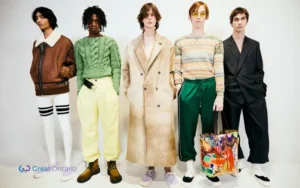As the end of 2024 is near, digital fashion is redefining self-expression and fashion. Digital fashion now blends AR, AI, and digital experiences. It is a key part of modern-day culture. Fashion has moved beyond the physical realm. It now exists inside the digital international. Users can explore, experiment, and express themselves like never before. This year will deliver trends that will transform our view of fashion. Here’s a complete examination of the top five virtual fashion trends you won’t want to miss in 2024.
1. AR Try-Ons: Digital Meets Physical Fashion
An essential trend in digital style is AR try-on tech. It is transformative. These try-ons permit users to check fashion in a virtual area before buying. They assist in bridging the gap between online and in-store buying. Augmented reality lets clients use their devices to overlay digital objects on themselves. These items include clothes, accessories, and cosmetics. This offers a realistic preview of the way an object would appear without having to try it on.
Key Benefits of AR Try-Ons:
-
Better Shopping: A real-time, 3-D preview boosts clients’ confidence in their purchases.
-
AI generation gives customized styling guidelines. It improves buying by matching a person’s tastes.
-
Reduced Return Rates: Customers are less likely to go back for items if they can see them before buying. This boosts pride and sustainability.
Retail giants like Sephora and IKEA have used AR try-ons. In 2024, more fashion brands will adopt this technology to enhance buying. They aim to merge convenience with customization.
2. Digital Fashion: Owning Clothes Beyond Reality
The rise of non-fungible tokens (NFTs) has revolutionized virtual ownership, especially in art. Digital clothing will allow fans to “put on” designer pieces on social media and in virtual areas. NFT fashion offers consumers specific ownership of those digital pieces. This makes digital style collectible, precise, and very valuable.
Why Digital Clothing and NFTs Matter in 2024:
-
Exclusive Ownership: NFTs prove possession and rarity. They make digital pieces distinct virtual assets.
-
Environmental Sustainability: Digital clothing cuts the environmental harm of conventional fashion.
-
Creative Freedom: Digital fashion designers can create without physical limits.
Pioneers in virtual fashion, like Dress X and The Fabricant, are making great virtual clothes. Gucci and Louis Vuitton are becoming members of the NFT trend. They provide a brand-new way for customers to express themselves online.
3. Metaverse fashion shows bring people together.
As the metaverse grows, so do the chances for fashion brands. They can create immersive, interactive events. Virtual fashion shows are now mainstream. They let designers share their latest collections with a global audience. These shows go beyond traditional runways. They let participants experience fashion in a 360-degree, interactive environment.
Highlights of Metaverse Fashion Shows in 2024:
-
Global Accessibility: Metaverse fashion shows let a global audience attend. They expand brand reach and inclusivity.
-
Interactive Experiences: Attendees can interact with virtual models and explore collections. They can also buy items from the virtual show.
-
Innovative Design Concepts: Without a runway’s limits, designers can test avant-garde, futuristic designs.
Major brands like Balenciaga and Dolce & Gabbana now hold metaverse fashion shows. This trend will only gain momentum. Virtual platforms are democratizing fashion. They are changing how we view and engage with high fashion.
4. Personalized Fashion with AI
Artificial Intelligence is playing a crucial role in fashion personalization. AI-driven recommendations analyze user preferences, body type, and buying history. They suggest tailored fashion items, creating a unique shopping experience. This tech enables a tailored approach to fashion. It saves users time and improves their shopping experience.
Benefits of AI-Driven Fashion Personalization:
-
AI suggestions save users time by finding their preferred options.
-
Higher Customer Satisfaction: Personalized recommendations boost satisfaction. Consumers find exactly what they want.
-
Improved Retail Strategy: Brands now understand consumer behavior. This helps them decide on future collections.
Brands like Stitch Fix and Zalando are using AI to enhance shopping. AI will be more advanced in 2024. We can expect better, personalized recommendations. They will change how we shop and engage with fashion.
5. Avatar Customization in Virtual Worlds
Avatars are more than digital representations. They’re becoming extensions of our real-world identities. There is a fast-growing trend to customize avatars in virtual spaces. This includes their clothing, hairstyles, and accessories. Platforms like Fortnite, Roblox, and Second Life let users customize their avatars. They can dress them according to their style.
Why Avatar Customization Matters:
-
Avatars enable users to create unique representations of themselves in online interactions.
-
High-fashion brands are teaming up with virtual platforms. They aim to create exclusive avatar clothing lines.
-
Cross-Platform Continuity Users can keep their unique style across virtual worlds. This reinforces their brand.
In 2024, avatar customization will become more advanced. More brands will partner with virtual platforms. They will offer exclusive, trendy pieces for the growing number of digital natives.
Conclusion
In 2024, virtual fashion is a revolution, not a trend. It changes how we express ourselves and connect with brands. It also redefines our online identities. AR try-ons, NFT clothes, and metaverse events are expanding fashion beyond the physical. They invite everyone to explore new frontiers of style and self-expression. AI personalization and avatar customization are part of this trend. Virtual fashion’s rise is making the industry more inclusive. It is also boosting global access to high fashion, creativity, and sustainability. As we evolve, these trends will lead to a more connected, innovative, and expressive future.
FAQ’S
Q1. What is virtual fashion, and why is it important in 2024?
Ans: Virtual fashion is digital clothing and accessories. They exist only in virtual spaces, like AR try-ons, avatars, and NFT fashion. In 2024, it is changing how we engage with fashion. It offers new ways to express ourselves, be sustainable, and be creative.
Q2. How does augmented reality (AR) enhance the shopping experience?
Ans: AR try-ons let customers see clothes and accessories in real-time on their phones or tablets. This helps them make better buying decisions. It also reduces return rates, as shoppers can see how items look on them before buying.
Q3. What is NFT fashion, and how does it work?
Ans: NFT fashion uses digital clothing and accessories. They are unique tokens on the blockchain. These tokens prove ownership. They let users “own” virtual fashion. They can wear it on social media or in virtual worlds.
Q4. How are metaverse fashion shows different from traditional ones?
Ans: Metaverse fashion shows are in immersive virtual worlds. They let global audiences participate. They offer interactive experiences. Users can engage with collections, explore designs, and buy items in the virtual space.
Q5. How does AI improve fashion personalization?
Ans: AI fashion tools analyze a user’s style, body type, and shopping history to suggest clothes. This tech helps users find items that fit their preferences. It makes shopping efficient, enjoyable, and tailored to individual preferences.
Q6. Why is avatar customization popular in virtual worlds?
Ans: Avatar customization lets users show their style and identity in virtual spaces. It makes online interactions more personal and engaging. Many platforms now work with fashion brands. They provide exclusive clothing and accessories for avatars. This creates a unique way to express oneself in digital spaces.








